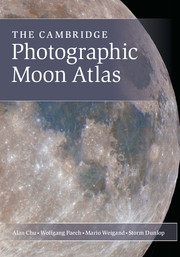Book contents
- Frontmatter
- Preface
- Advice on using this book
- Contents
- The Moon – an introduction
- Atlas of lunar formations
- 1 Mare Smythii
- 2a Mare Crisium
- 2b Mare Crisium
- 3 Cleomedes
- 4 Endymion
- 5 Atlas/Hercules
- 6 Montes Taurus
- 7 Palus Somni
- 8a Mare Fecunditatis
- 8b Mare Fecunditatis
- 9 Langrenus/Petavius
- 10 Mare Australe
- 11 Vlacq
- 12 Vallis Rheita
- 13a Mare Nectaris
- 13b Mare Nectaris
- 14 Rupes Altai
- 15 Abulfeda
- 16 Theophilus
- 17 Sinus Asperitatis
- 18 Statio Tranquillitatis
- 19a Mare Tranquillitatis
- 19b Mare Tranquillitatis
- 20a Mare Serenitatis
- 20b Mare Serenitatis
- 21 Posidonius
- 22 Lacus Mortis
- 23 Aristoteles/Eudoxus
- 24 Montes Caucasus
- 25 Autolycus/Aristillus
- 26 Cassini
- 27 Montes Alpes
- 28 Plato
- 29 Montes Teneriffe
- 30 Archimedes
- 31a Montes Apenninus
- 31b Montes Apenninus
- 32 Mare Vaporum
- 33 Rima Ariadaeus
- 34 Rima Hyginus
- 35 Sinus Medii
- 36 Hipparchus
- 37a Ptolemaeus
- 37b Ptolemaeus
- 38 Rupes Recta
- 39 Regiomontanus
- 40 Maurolycus
- 41 South Pole
- 42 Clavius
- 43 Tycho
- 44 Schiller
- 45 Palus Epidemiarum
- 46 Pitatus
- 47 Mare Nubium
- 48 Fra Mauro
- 49 Mare Cognitum
- 50 Mare Insularum
- 51a Copernicus
- 51b Copernicus
- 52 Eratosthenes
- 53a Mare Imbrium
- 53b Mare Imbrium
- 54 Sinus Iridum
- 55 Gruithuisen
- 56 Mare Frigoris
- 57 North Pole
- 58 Aristarchus
- 59 Kepler
- 60 Seleucus
- 61 Reiner
- 62 Letronne/Hansteen
- 63 Gassendi
- 64 Mare Humorum
- 65 Schickard
- 66 Sirsalis
- 67 Grimaldi
- 68 Mare Orientale
- 69 Lunar Farside
- Glossary
- Index of lunar features
- Image credits
- Further reading and references
36 - Hipparchus
Published online by Cambridge University Press: 05 October 2012
- Frontmatter
- Preface
- Advice on using this book
- Contents
- The Moon – an introduction
- Atlas of lunar formations
- 1 Mare Smythii
- 2a Mare Crisium
- 2b Mare Crisium
- 3 Cleomedes
- 4 Endymion
- 5 Atlas/Hercules
- 6 Montes Taurus
- 7 Palus Somni
- 8a Mare Fecunditatis
- 8b Mare Fecunditatis
- 9 Langrenus/Petavius
- 10 Mare Australe
- 11 Vlacq
- 12 Vallis Rheita
- 13a Mare Nectaris
- 13b Mare Nectaris
- 14 Rupes Altai
- 15 Abulfeda
- 16 Theophilus
- 17 Sinus Asperitatis
- 18 Statio Tranquillitatis
- 19a Mare Tranquillitatis
- 19b Mare Tranquillitatis
- 20a Mare Serenitatis
- 20b Mare Serenitatis
- 21 Posidonius
- 22 Lacus Mortis
- 23 Aristoteles/Eudoxus
- 24 Montes Caucasus
- 25 Autolycus/Aristillus
- 26 Cassini
- 27 Montes Alpes
- 28 Plato
- 29 Montes Teneriffe
- 30 Archimedes
- 31a Montes Apenninus
- 31b Montes Apenninus
- 32 Mare Vaporum
- 33 Rima Ariadaeus
- 34 Rima Hyginus
- 35 Sinus Medii
- 36 Hipparchus
- 37a Ptolemaeus
- 37b Ptolemaeus
- 38 Rupes Recta
- 39 Regiomontanus
- 40 Maurolycus
- 41 South Pole
- 42 Clavius
- 43 Tycho
- 44 Schiller
- 45 Palus Epidemiarum
- 46 Pitatus
- 47 Mare Nubium
- 48 Fra Mauro
- 49 Mare Cognitum
- 50 Mare Insularum
- 51a Copernicus
- 51b Copernicus
- 52 Eratosthenes
- 53a Mare Imbrium
- 53b Mare Imbrium
- 54 Sinus Iridum
- 55 Gruithuisen
- 56 Mare Frigoris
- 57 North Pole
- 58 Aristarchus
- 59 Kepler
- 60 Seleucus
- 61 Reiner
- 62 Letronne/Hansteen
- 63 Gassendi
- 64 Mare Humorum
- 65 Schickard
- 66 Sirsalis
- 67 Grimaldi
- 68 Mare Orientale
- 69 Lunar Farside
- Glossary
- Index of lunar features
- Image credits
- Further reading and references
Summary
Hipparchus 5.1°S, 5.2°E
Hipparchus is a giant, heavily ruined crater, with a diameter of 138 km and a depth of 3 km, which arose in the Pre-Nectarian period. The southeast crater wall is broken split by two deep, broad gaps. The northwestern wall of the crater is likewise largely destroyed, and exhibits wide gorges that are open towards Rima Réaumur (about 30 km long) and to Sinus Medii. Rima Réaumur encounters Rima Oppolzer at almost a right angle. Both are linear fracture zones, probably associated with the lava surface of Sinus Medii.
The floor of Hipparchus exhibits mountain peaks, small hills, crater pits, ghost craters and the 30-km, well-preserved, young crater Horrocks. The southwestern crater wall of Hipparchus is almost completely destroyed, and is covered with a group of both large and small craters.
The crater walls of Hipparchus generally consist of a series of holes, furrows, rilles, hills and ridges. The pattern that these features exhibit is radial to the centre of the Imbrium Basin. They are part of the Imbrium Sculpture and may be followed over a distance of more than 1000 km.
Albategnius 11.7°S, 4.3°E
Albategnius is a prominent, very conspicuous complex crater with a diameter of 114 km, an imposing central peak and a flat, smooth crater floor. The inner walls have been heavily eroded by landslides and intervening valleys, and is saturated with craterlets. The western crater wall is overlapped by the 44-km wide crater Klein. Under grazing illumination at sunrise (waxing Moon), numerous, very shallow, circular depressions are visible. Two of these lie directly to the east of the central peak, and two more to the south. The highest summit on the central peak has a pit that is about 1 km in diameter.
- Type
- Chapter
- Information
- The Cambridge Photographic Moon Atlas , pp. 115 - 116Publisher: Cambridge University PressPrint publication year: 2012



